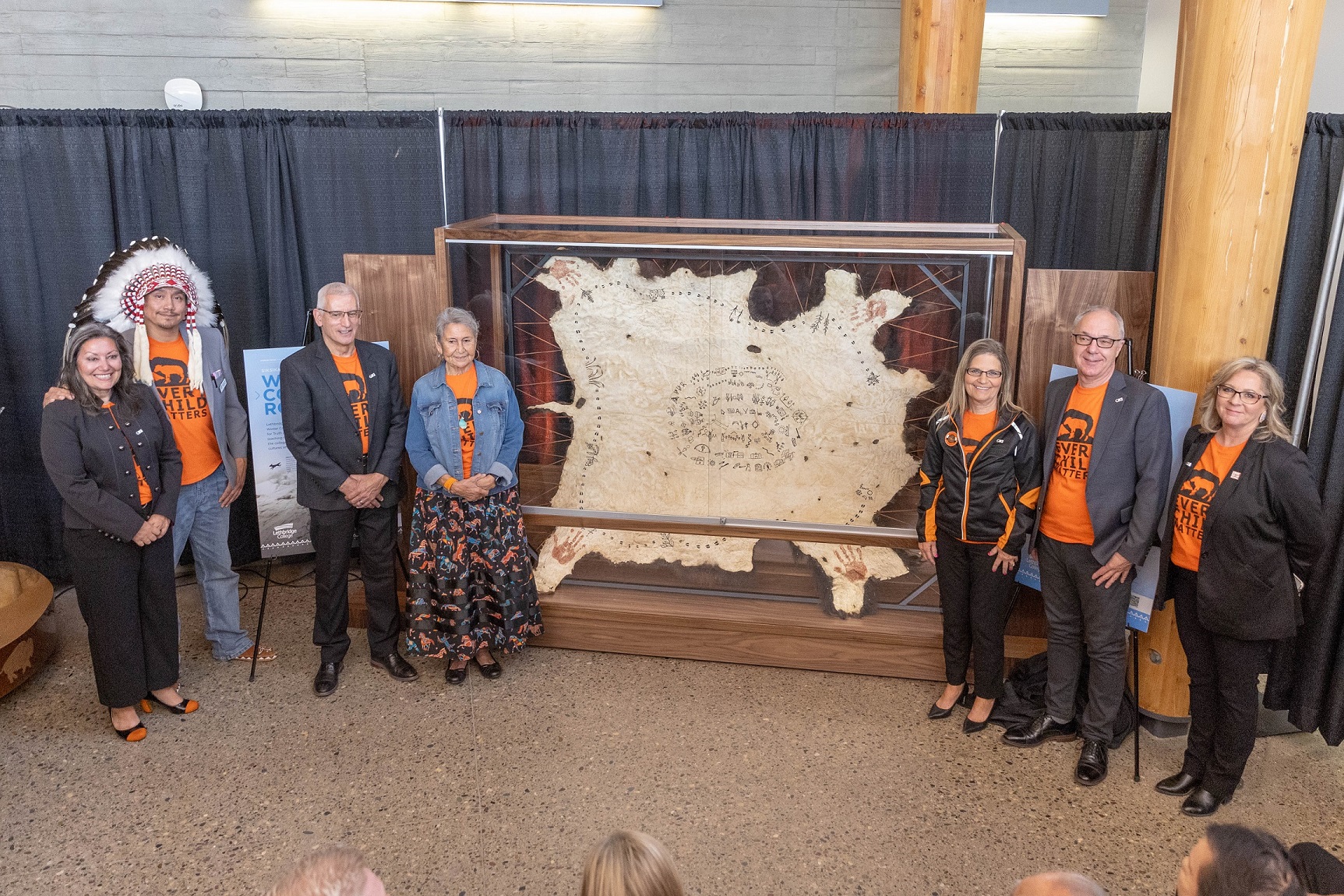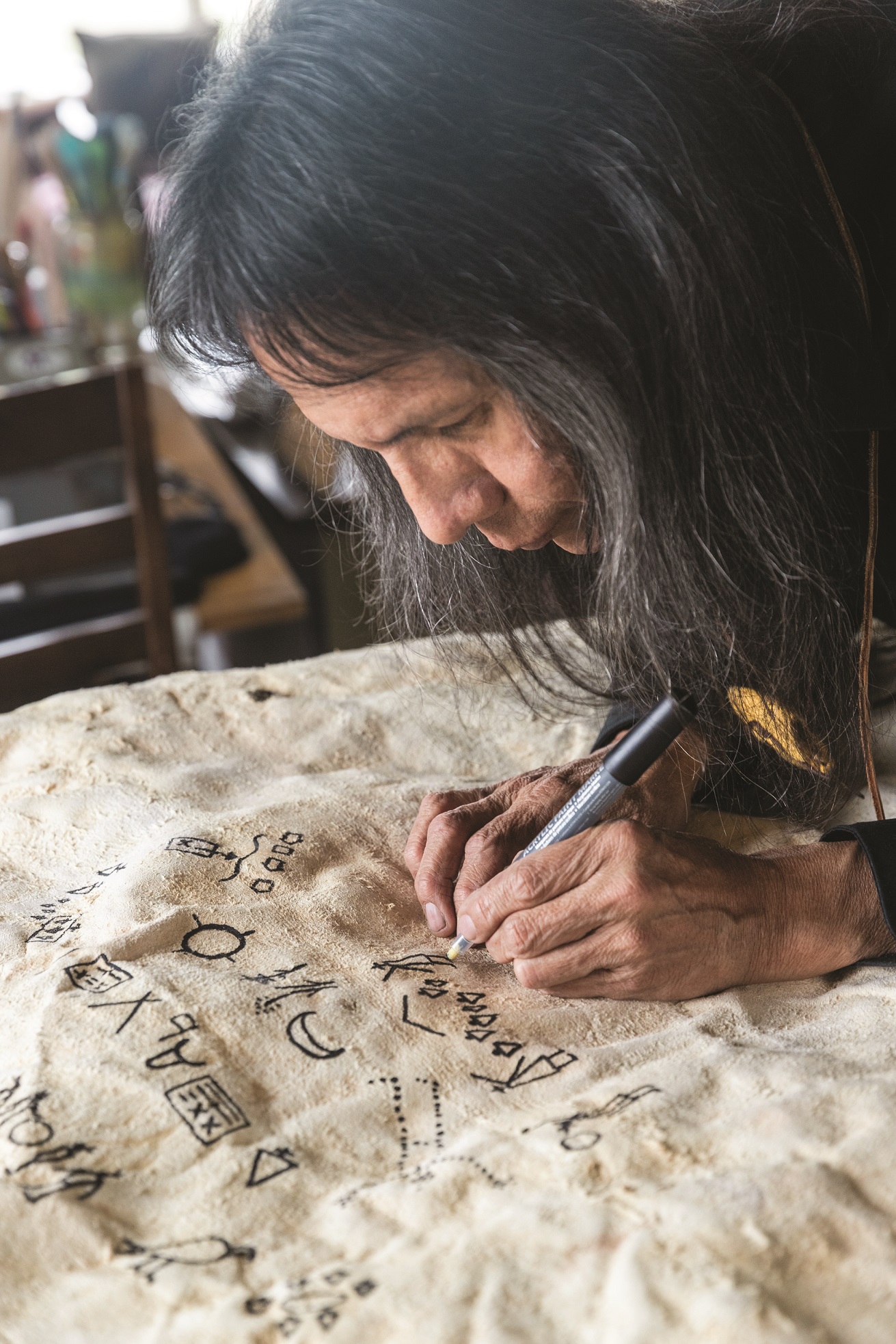
Lethbridge College unveiled its traditional Buffalo Winter Count Robe today as part of events surrounding the National Day for Truth and Reconciliation. The robe will be used as a teaching tool, as a record of major college events, and as a sign of the college’s ongoing work to understand and honour traditional cultures and ways of knowing.
Kainai Knowledge Keeper and artist William Singer III (Api’soomaahka/Running Coyote) painted the college’s robe over the spring and summer. Colleagues from departments across campus – including Indigenous Services, Communications, Marketing, Student Affairs, and Executive Leadership – came together with Kainai Kaahsinnoonik (Grandparent) Peter Weasel Moccasin (Miiniipooka/Berry Child) to create the list of events to be included in Lethbridge College’s robe.
“We are honoured to share this beautiful robe with our community today,” says Lethbridge College President and CEO Dr. Brad Donaldson. “Not only does it tell the story of the college in a meaningful way, but it also is a way for us to lead in implementing the actions of the Truth and Reconciliation Commission. This robe will serve as a visual reminder that the college’s history and the history of the Siksikaitsitapi are inexorably linked.”
A Winter Count is a pictorial calendar or history painted on a buffalo hide created by many Northern Great Plains First Nations that carries the story of a community. Traditionally, each nation would choose a single keeper of the winter count; each year, at the first snowfall, the keeper would consult with elders to reach a consensus for choosing a name and pictograph for the year, and then would add that image to the robe. These Winter Count robes were used as guideposts in transmitting oral tradition and history. The robe unveiled today will be used to share the college’s history with its community, from the land where it was built, to its foundation in 1957, through to today, and for seasons to come.

“Winter Counts were created and are still created as a way of communicating, of transferring knowledge,” says Singer. “Looking at a history, this robe tells the story of the college. It’s for teaching as well. Some of the symbols are straightforward. Others have different meanings. And there are also elements where you have to take action. Each symbol has a story, and they all fit into each other and form a chain until the end, and once you fill up a hide, you start another. There is space left on the college’s winter count so the story can be added to.”
The idea of Lethbridge College acquiring a Winter Count robe stemmed from the college’s participation in the McConnell Foundation’s Social Innovation Lab on Reconciliation in the Postsecondary Sector. Wanting the college to be a catalyst for change, the Indigenous Services team felt a Winter Count robe would not only be a prominent symbol of traditional Blackfoot Territory on campus, but it would also reaffirm the close relationship between the college and Indigenous communities in southern Alberta – specifically the Piikani and Kainai First Nations. Please see the story written by Tina Karst in the fall 2023 issue of Wider Horizons to learn the rest of the story of how the robe came to be at Lethbridge College.
The traditional Buffalo Winter Count Robe will typically be displayed on campus for students, employees and visitors to learn from. However, it will be placed in a portable showcase so that it can be transported to other areas to be used in different ceremonial events, including convocation, or to classrooms and other campus spaces to be used as a learning tool for students, community members and friends of the college.
About the artist
William Singer III (Api’soomaahka/Running Coyote) is a member of the Kainai First Nation. He was named after his great uncle Running Coyote, a Blackfoot warrior who, in his later years, created pictograph art for elder warriors who wanted their stories saved for future generations. Knowing this, Singer said it is his duty to carry on his namesake’s legacy by surviving in two worlds and maintaining the Blackfoot worldview. Singer’s main profession is as an artist/illustrator with 40 years of experience, and his work is deeply rooted in the Blackfoot worldview and uses painting to teach. Along with his art, Singer is a dedicated entrepreneur, environmental and political activist who uses Blackfoot ecological knowledge and protocol in his work.
Singer started collaborating with the college in 2017. His first project was creating a special painting for Founders’ Square, which was built as a way of commemorating Lethbridge College’s 60th anniversary. The next major project Singer worked on was in 2020, when he helped create an online tour of the traditional plants found in the coulees behind campus. That project launched the Iissksiniip Coulee Walk, an interpretative self-guided tour that opened in fall 2021 and explores the traditional plants found in the area and explains their uses.
Learn more
The fall issue of Wider Horizons, Lethbridge College’s community and alumni magazine, is focused on stories that celebrate the buffalo – both the “old” (the animal) and the “new” (education). Extra copies can be found in Centre Core on campus, and all stories can be access online at widerhorizons.ca.